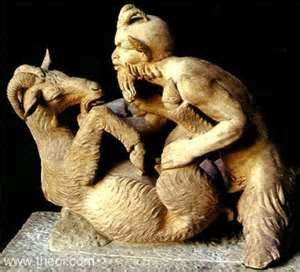The Origins of Valentines Day


Originally posted on February 11, 2014
In Rome, they celebrated a fertility festival called Feast of Lupercalia, named after the pagan deity, Lupercus. The festival occurred February 14-15. In the beginning, a group of roman priest called Luperci would gather in a cave where the founders of Rome (Romulus and Remus) were supposedly born and cared for by a she wolf.
In the cave, (some say) they would have sex with a goat (a sacrifice dedicated to Pan, a goat) for fertility and a dog for purification. The goat skin would be cut into strips and then dipped into sacrificial blood. The men would run through Rome slapping the bloody skin on women and crops. They believed the women would be more fertile next year. Children were involved as well. Young girls would write their names on a piece of paper and place it in a box. The names drawn from the box would be paired up with a boy to engage in sexual activities for a year.
Emperor Claudius II thought men were better soldiers when they were not married and without children. He banned marriages for young men as well as the names in a box practice. A Roman Priest named St. Valentine disagreed with him and continued the names in a box practice and secretly married young woman and men. He saw nothing wrong with the Feast of Lupercalia. St. valentine was caught. Some say he was hung and some say he was beheaded.
Pope Gelasius banned the feast of Lupercalia and all holidays (Christmas, Easter, etc) by saying they were unchristian. People began to leave the Christian churches and converted to paganism. Priests thought of a way to bring Christmas back to get the people to convert back into Christians. The priest gathered together and renamed the Feast of Lepurcalia to St. valentines Day. They changed the valentine character into a Christian character saying he healed the blind and cured the sick. The priests brought back the picking a name from a box practice, except saints names were placed in the box. Which ever saint’s named was pulled, the child had to emulate the saint for 1 year. Today, it’s known as The Confirmation in the Catholic Church. They made it a day about love.
© 2011 – 2024 TheAfroLounge.com. All Rights Reserved. Unauthorized use and/or duplication of this material without express and written permission from this blog’s author and/or owner is strictly prohibited. Excerpts and links may be used, provided that full and clear credit is given to TheAfroLounge.com, with appropriate and specific direction to the original content.
